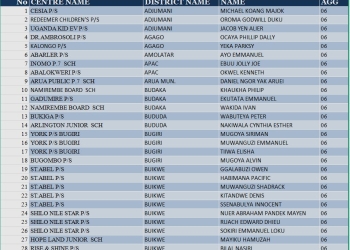The Real estate is one of the fastest growing sectors yet by less taxed. However, in the recent past, Kampala traders have continued to petition government on landlords increasing rental fees implying that the owners of the commercial buildings are earning abnormal profits yet not complying.
In order to ensure their compliance, Paddy Ocheng, the Manager in the Rental unit, Domestic Taxes Department shares all nitty-gritty in the sector.
What is Rental Income Tax and how is it operating in Uganda?
Rental income is income that is generated by a person for leasing or renting out immovable property, now this immovable property could be land or buildings for a consideration.
Rental income is also tax that is levied on any person who generates rental income; that person could be an individual that is owning property from where they generate rental income or it could be a company or a retirement farm, estate, partnership as long as one generates rental income from that property owned through leasing or renting.
How is URA handling the issue of revenue leakages in the Rental sector?
Rental income tax admittedly has had some gaps over the years and notably URA has invested in different initiatives to ensure that these gaps are plugged. Some of these include; wide spread sensitization campaigns that we are conducting. We have observed over the years many of our taxpayers are not fully aware of rental income tax and the requirements to comply with rental income tax so we have rolled out tailor made sensitization campaigns that include tax literature that has been translated in a variety of local languages to ensure that different players in the rental tax sector understand their tax obligations.
We have also carried out sensitizations through media like on television and radios to reach out to a wider mass. We conduct weekly webinars and utilize the mobile outreach services through the Tujenge bus.
As URA, we have realized that some of our taxpayers are not able to come seminars and workshops so we have tax katales where we go to the market place and set up tax hubs.
The other initiatives include collaborations with other Government agencies. We have had exchange of information with MDAs such as Kampala Capital City Authority, Ministry of Lands, UMEME, National Water & Sewerage Corporation National Identification & Registration Authority. Most of the information that we have gathered from these MDAs has been put together in a system because we are also leveraging on technology, a system called the Rental tax compliance system that matches data from the different MDAs and helps us to identify taxpayers and landlords who are not registered and those who are under declaring.
The other initiatives to ensure that we bridge the gaps in the rental income tax have been our systematic and targeted compliance reviews and audits and these especially target the gaps around taxpayers that have engaged in aggressive tax evasion schemes. So we carry out data driven and systematic audits to be help them comply.
We have also intensified our field inspection visits in addition to collaborations with the Local council one Chairpersons to ensure that we leverage the data that is resident with them to be able to sensitize and also reach out the different landlords for purposes of compliance.
All these initiatives have helped grow our collections in rental tax. For example, over the past five years, we had an average of 27% growth comparing our collections year on year. Every year through these initiatives we have undertaken, we have been able to grow. We had a bit of a slow down during the COVID period but this financial year, we are headed for the best. The collections of July 2022 to March 2023 were UGX131.4 billion compared to UGX 97 billion that had been collected around the same period the previous financial year.
In terms of growth of the register, at the beginning of last financial year, we had about 80,000 landlords registered for rental tax but as at end of April 2023, we have 152,000 landlords spread across the country. It is an 89% growth, so whereas there are gaps, these interventions have helped us achieve tremendous results.
How does URA determine who pays rental tax and what measures does URA use to collect the tax?
In rental income tax, there is what we call chargeable income which we apply to a prescribed rate of tax. In chargeable income, we look at your gross rental incomes and for individuals, we reduce that gross rental income with what we call a tax free threshold below a certain level of your gross rental income. Therefore, one is not expected to pay tax, now the tax threshold is UGX 2, 820,000. So if your gross annual rental income is below UGX2,820,000 and you are an individual, then you are not required to pay rental income tax. However, if your rental gross income exceeds 2,820,000, the rental income tax that you pay is at a rate of 12% on the difference between your gross rental income and the tax free threshold of UGX2, 820,000.
Now for non-individuals like companies, retirement benefit schemes, the formula differs. Here, we look at their gross rental income and then we allow them up to 50% of that gross rental income to cater for expenses that have been incurred in generating this income.
Are the conditions favorable to pay rental income since there is continuous conflict between tenants and their landlords on payments?
The effects of premises being vacant are taken care of in arriving at what is called the gross rental income. For example, if someone has five rental units in Banda and from each unit they charge rent of UGX 500,000 per month, so if these units are fully occupied throughout the 12 months’ period, it means that every month they are generating 2.5 million from the 5 units. And in a year they will have generated UGX2,500,000 multiply by 12 which is UGX 30million so that will be the gross rental income.
There are also instances were some of the units are not occupied during the 12 months’ period. Now that will be taken into account in arriving at the gross rental income. For instance, if one of the units was occupied for only 6 months, we will get the UGX 500,000 multiply by 12, for the four units and then for the 5th unit that was occupied for only 6 months, the gross rental income from it will be the UGX 500,000 multiply by the 6 months. So you will find that the gross rental income for the landlord whose units were not fully occupied will be lower.
How does URA ensure that every landlord is compliant?
The system of payment of taxes runs a self-declaration regime, so the landlord is expected to make these declarations themselves at the end of the year indicating the rental income that they have earned or generated during that year of income.
We know that sometimes these declarations are made dishonestly that is why we go and do field inspections to verify some of these facts. Sometimes we use data from our third party partners to establish occupancy and the rates that were paid during the year but in essence, it is the landlord that is supposed to honestly make these declarations and indicate clearly how much they earned. For companies, an allowance of 50% of what they earned is given to them and then a tax of 30% applied on the difference of 50%.
This interview will be shared in series to allow taxpayers/readers to understand the detail of what the sector is and how it is taxed.

















